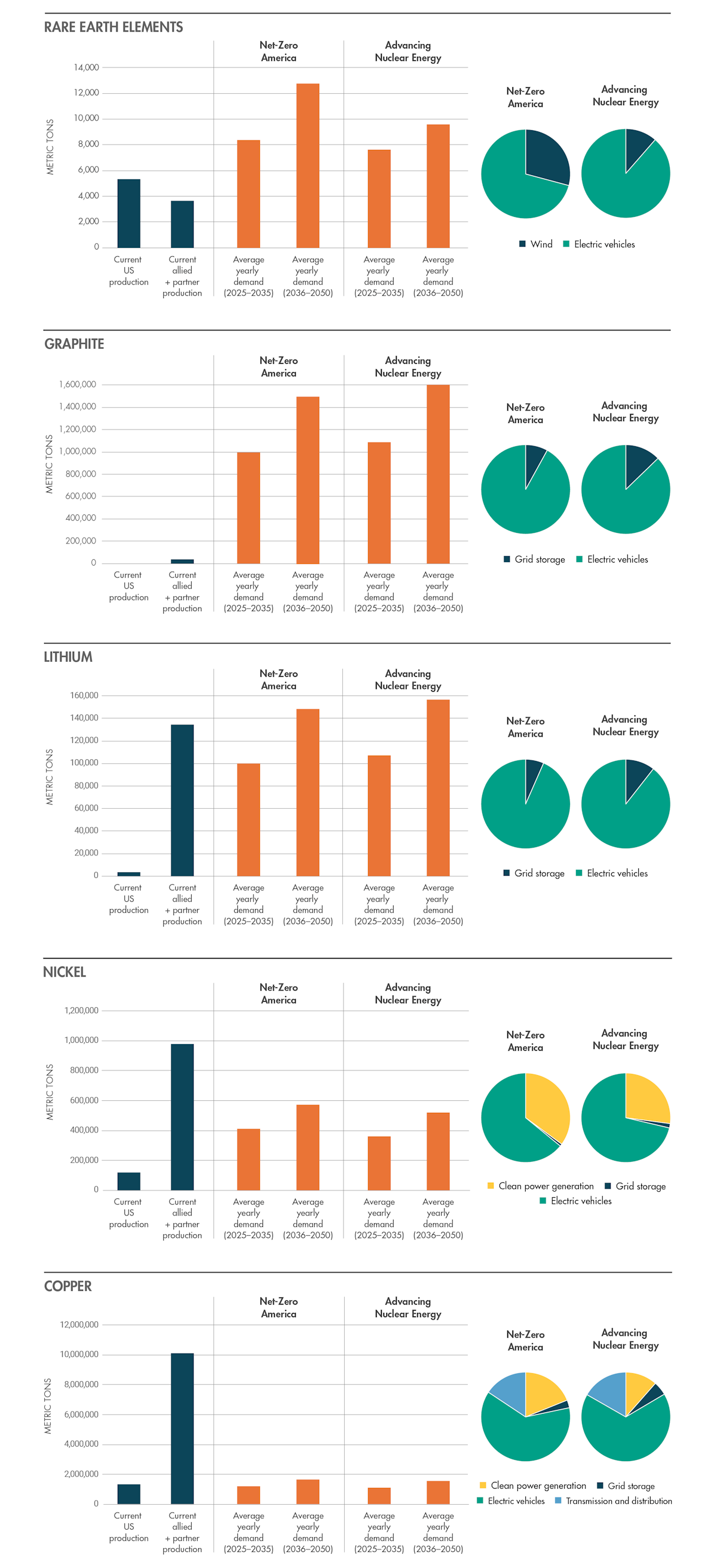Metals for the Future
What Minerals Will The U.S. Need for Clean Technologies?

-
-
Share
-
Share via Twitter -
Share via Facebook -
Share via Email
-
Executive Summary
Currently, the United States seeks to strike a difficult balance between competing for the leading edge of advanced energy technologies like batteries and solar photovoltaics and protecting those industries from vulnerable overdependence on imports of key raw materials and components. Left unaddressed, mineral supply chain constraints may ultimately force policymakers to choose between pursuit of climate ambitions with mass-imported goods or cultivating domestic capacity in strategic industries. Avoiding this dilemma requires strong public policy support, as prevailing market incentives exhibit a regular bias toward cheaper and often highly problematic critical mineral imports from overseas.
Yet we cannot design good policy without a more concrete understanding of future national mineral demands. Accelerating trends such as increased adoption of new energy and vehicle technologies offer the U.S. the potential to bolster national energy abundance and seize leadership in emerging global industries with strong growth potential. But critical mineral inputs for these industries remain a persistent weak point in U.S. industrial capabilities and strategy.
This report estimates U.S. mineral needs for power and road transportation sector decarbonization by 2050, provides policy guidance on the states of those mineral supply chains from a U.S. perspective, and identifies which commodities warrant prioritization in national critical minerals strategy. This empirical quantification better connects policy efforts focused on critical minerals with the possible magnitude of future national mineral demands.
Electricity generation, electricity transmission, and electric vehicles will drive demand for raw materials like aluminum, nickel, and copper that matches or exceeds economy-wide national consumption today. We identify graphite, lithium, and rare earth elements, in particular, as priority energy technology minerals for which current production by the U.S. and its allies and partners falls well short of likely future needs (Figure ES 1).
Electric vehicles carry especially significant weight in determining future U.S. mineral needs. Even if we assume that nickel-free and cobalt-free lithium-iron-phosphate (LFP) battery packs comprise 60% of the future market share for road vehicles of all classes, establishing reliable supplies of battery-grade nickel and cobalt may remain a major challenge. Highly ambitious electric vehicle adoption goals or large-scale efforts to export American-made EVs overseas could consume double the rare earth elements, nickel, and copper over the next 25 years relative to nationwide construction of clean power and transmission infrastructure.
Without muscular industrial policy and economic diplomacy, critical mineral demands will force policymakers to prioritize between large-scale deployment of advanced energy technologies and resilient, domestically-bolstered supply chains. Underinvestment in secure supply chains may leave the U.S. a mere mass importer of materials and equipment, ceding leadership in strategic technologies and accepting geopolitical vulnerabilities. Alternatively, immature supply chains risk saddling households, firms, and infrastructure projects with high costs and leaving better economies of scale beyond reach.
In general, these results emphasize the importance of expanded domestic production alongside close international coordination for ensuring that the U.S. can meet future clean technology sector needs.
Key findings:
- Electric vehicles account for two-thirds of future national demand for many clean energy minerals, with graphite, lithium, and rare earth elements emerging as key priorities.
- Graphite: Demand for battery graphite will grow to 1 million to 1.5 million tons per year—roughly 16 and 25 times greater than the amount contained in domestically sold EVs in 2023, with a negligible quantity produced domestically.
- Lithium: At roughly 3,000 tons per year, current U.S. production can only meet 2-3% of future lithium demand from battery deployment (100,000 to 150,000 tons per year).
- Rare earth elements (REE): Electric vehicle motors and wind turbines alone may drive REE demand that exceeds U.S. production by over 50% over the next decade.
- Nickel and cobalt: Even a large market shift from nickel-manganese-cobalt batteries to nickel-free and cobalt-free lithium-iron-phosphate batteries will not eliminate heavy U.S. reliance on nickel and cobalt imports from China, particularly given minimal U.S. cobalt production.
- Aluminum: Annual deployment of electric vehicles, renewables, and transmission could use as much aluminum as the entire U.S. economy does today.
- Nickel: Clean technology usage of nickel may grow to 200-300% of current national consumption.
- Copper: Clean technology copper consumption may reach 1.1 to 1.6 million tons per year, compared to U.S. production of around 1.25 million tons in 2023.
- Steel: Future clean technology usage of steel may grow to match 23-38% of current national consumption.
- Financial support for processing should prioritize minerals with limited existing domestic capacity and smaller market volumes, in order to reduce risks for trailblazing projects and avoid costlier policy support for commodities with larger trade flows.
- Expanding domestic mining and processing of critical minerals will ultimately require progress across multiple policy areas including permitting, trade, targeted financial support, and coordinated use of financial and physical tools and contracts.

Supplementary Information:
1. Electric Vehicle Materials Calculations
2. Data for Figures and Tables
3. Power Sector Material Calculations and All Sector Summary Table Data
4. Transmission Materials Calculations
This report was updated on October 15, 2024.



